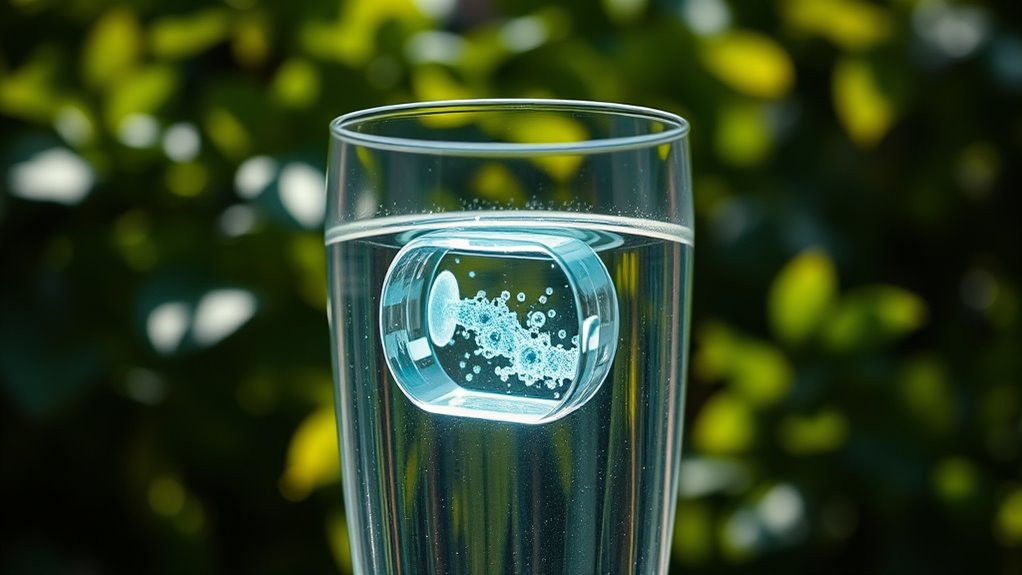Nanotechnology provides innovative solutions to deliver clean water anywhere. Ultra-thin membranes with nanoparticles block bacteria, viruses, and chemicals efficiently, making filtration faster and more resource-efficient. Quantum dots target pollutants precisely, reducing chemicals needed and helping in remote areas or disaster zones. These advanced systems are customizable and scalable, ensuring safe drinking water in diverse environments. Keep exploring to discover how nanotech is revolutionizing global water safety and making clean water accessible everywhere.
Key Takeaways
- Nanotech membranes efficiently filter bacteria, viruses, and pollutants, enabling safe drinking water in diverse environments.
- Quantum dots selectively target and neutralize contaminants, reducing chemical use and treatment complexity.
- High surface area nanomaterials enhance filtration speed and effectiveness for micro-pollutants and stubborn contaminants.
- Customizable nanotech systems can be deployed in remote, disaster-affected, or resource-limited areas for reliable water purification.
- Ongoing advances aim to make nanotech water purification more affordable, scalable, and accessible worldwide.

Nanotechnology is revolutionizing water purification by offering innovative solutions to remove contaminants more efficiently. One of the most promising advancements involves the development of nanotech membranes, which are incredibly thin layers embedded with nanoparticles designed to filter out impurities at a molecular level. These membranes are highly effective at blocking bacteria, viruses, and chemical pollutants, making water safer to drink even in challenging environments. Unlike traditional filters, nanotech membranes can be customized to target specific contaminants, providing a versatile approach suited for various water sources. Their small pore sizes allow for rapid filtration without sacrificing flow rate, ensuring you get clean water quickly and reliably. Proper maintenance and understanding of filter lifespan are essential to maximize their effectiveness and longevity.
Nanotech membranes filter impurities at a molecular level, providing fast, reliable, and customizable water purification.
Quantum filtration is another cutting-edge technique that leverages the principles of nanotechnology to enhance water purification. This process uses quantum dots—tiny semiconductor particles—that can selectively adsorb or neutralize pollutants at the nanoscale. When integrated into filtration systems, quantum filtration can identify and eliminate contaminants more precisely than conventional methods. This targeted approach reduces the need for chemicals or extensive treatment steps, making it a more sustainable and cost-effective option. Quantum filtration systems are particularly useful for removing heavy metals, organic compounds, and micro-pollutants, which are often difficult to eliminate through traditional means. As these systems become more refined, they’re increasingly capable of providing clean water in remote or disaster-stricken areas where conventional infrastructure might fail.
Both nanotech membranes and quantum filtration are leveraging the unique properties of nanomaterials—such as high surface area, reactivity, and selectivity—to push the boundaries of water purification. You benefit from their ability to deliver cleaner water in less time, with fewer resources and less waste. These technologies are not just about improving purification; they’re about making water treatment more adaptable to different environments, whether that’s a rural village, a developing country, or a space station. As research continues, expect these innovations to become more affordable and widespread, transforming how you access safe drinking water.
In essence, nanotechnology is opening a new frontier in water purification. By harnessing nanotech membranes and quantum filtration, you’re gaining access to systems that are smarter, faster, and more effective at removing even the most stubborn contaminants. This progress means that clean water isn’t just a luxury in well-equipped cities but a reality anywhere it’s needed most. You can look forward to a future where safe, pure water is available in every corner of the globe, driven by the incredible potential of nanotechnology.
Frequently Asked Questions
How Cost-Effective Is Nanotechnology Water Purification for Developing Countries?
Nanotechnology water purification can be cost-effective for developing countries, but its economic feasibility relies on addressing infrastructure challenges. You’ll find that initial investments may be high, yet long-term savings and health benefits make it worthwhile. By overcoming infrastructure hurdles, such as reliable power and maintenance, you can guarantee the technology’s affordability and sustainability, providing clean water access to communities that need it most.
Are Nanomaterials Used in Water Purification Environmentally Sustainable?
Think of nanomaterials as tiny warriors fighting pollution, but you wonder if their environmental impact is sustainable. Yes, they can be environmentally sustainable if designed with a mindful material lifecycle, reducing waste and toxicity. While some nanomaterials pose risks, ongoing research aims to minimize negative effects. You need to take into account their production, use, and disposal to ensure they serve as guardians of clean water without harming the planet.
What Are the Potential Health Risks of Nanomaterial Exposure?
You should be aware that nanomaterial toxicity poses potential health risks if you’re exposed to these tiny particles. Exposure can lead to health implications like inflammation, cellular damage, or toxicity, especially if inhaled or ingested. While nanotechnology offers benefits, it’s vital to handle nanomaterials carefully and follow safety guidelines to minimize health risks associated with nanomaterial toxicity and guarantee safe use in water purification.
How Long Do Nanotechnology Filters Typically Last Before Replacement?
Like a trusty steed from the Old West, nanotech filters usually last about 6 to 12 months before requiring replacement. Your filter lifespan depends on usage and water quality, so regular maintenance frequency is key. Keep an eye on performance; if water flow slows or quality drops, it’s time for a change. Proper upkeep guarantees you get clean water consistently, just like a well-maintained machine.
Can Nanotech Water Purification Remove All Types of Water Contaminants?
Nanotech water purification can remove many contaminants, but it doesn’t eliminate all types due to contaminant specificity and filtration limitations. You might find it effective against bacteria, viruses, and some chemicals, yet it may struggle with heavy metals or organic compounds. To guarantee safe drinking water, you should combine nanotech filters with other purification methods or choose systems designed for broader contaminant removal.
Conclusion
Imagine nanotechnology as a tiny superhero patrolling every drop of water, fighting off contaminants and making clean water accessible anywhere. With these powerful innovations, you’re not just quenching your thirst—you’re breaking down barriers to pure water worldwide. Every nanoparticle acts like a microscopic gatekeeper, ensuring safety and clarity. So, as you turn on your tap, remember, this tiny hero is working tirelessly behind the scenes, transforming how we access and enjoy clean water everywhere.









